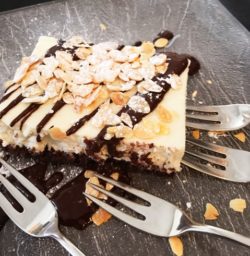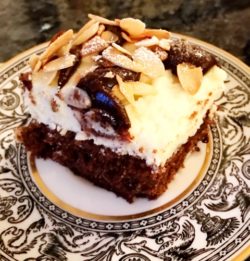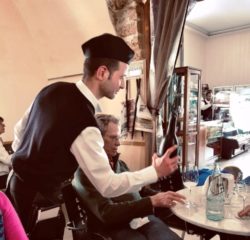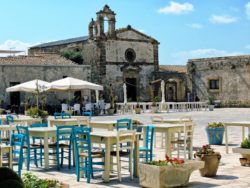Read Time: 7 Minutes Subscribe & Share
East Meets West
 Wise counsel from our Italian son-in-law led us to split a Sicily odyssey into two parts. Brilliant advice on several counts, including offering us an opportunity to compare two airports— Palermo and Catania. Airports always fascinate me. How they are designed (or not), what food is available, and the inevitable winding queues at Ryan Air, which make the lines for the eternal Rolling Stones seem paltry. Both Palermo and Catania airports receive scathing reviews, I’m guessing from folks who have never suffered through JFK. Catania is a lot easier to navigate than Palermo and the personnel, transport drivers, rental car agencies are all a lot more laid back. One trick that would have helped was the advantage of the special pre-reserved car (at an additional fee) waiting for you at your friendly international autonoleggios. But if you are like us and had to take a number and wait to pick up your car, eating at Catania’s airport is not the dining tragedy we’ve found at Dulles.
Wise counsel from our Italian son-in-law led us to split a Sicily odyssey into two parts. Brilliant advice on several counts, including offering us an opportunity to compare two airports— Palermo and Catania. Airports always fascinate me. How they are designed (or not), what food is available, and the inevitable winding queues at Ryan Air, which make the lines for the eternal Rolling Stones seem paltry. Both Palermo and Catania airports receive scathing reviews, I’m guessing from folks who have never suffered through JFK. Catania is a lot easier to navigate than Palermo and the personnel, transport drivers, rental car agencies are all a lot more laid back. One trick that would have helped was the advantage of the special pre-reserved car (at an additional fee) waiting for you at your friendly international autonoleggios. But if you are like us and had to take a number and wait to pick up your car, eating at Catania’s airport is not the dining tragedy we’ve found at Dulles.
Serious Business in Avola
Our Italy Insider arranged for us to stay in a nature preserve near Noto for our first week and then in a beach resort at the foot of Mount Etna for the  second one. While my husband was counting on his explorations of Greek and Roman ruins and current Sicilian vineyards, I just wanted to try Sicilian pastries, seafood, citrus, every vegetable in sight, and the Sicilian breakfast of champions – granita con panna with brioche. My first wish was granted when we stopped at Restaurant Prua in Avola. Right on the sea, easy parking, at the prized nexus of Almonds and Nero d’Avola, Prua has a lovely minimalist interior and a staff that handles families with children with noted Italian ease. Avola, like so many towns under the temper tantrums of Mount Etna, was destroyed by the 1693 earthquake. The city was relocated and redesigned by the architect Angelo Italia, a remarkable Jesuit friar. who also participated in the redesign of Noto. Italia’s plan for the new Avola utilizes a hexagonal design and geometric symmetry combined with large open spaces and straight roads between buildings to lessen the effects of future earthquakes. You can easily walk through this remarkable and compact 400-year-old vision of urban renewal.
second one. While my husband was counting on his explorations of Greek and Roman ruins and current Sicilian vineyards, I just wanted to try Sicilian pastries, seafood, citrus, every vegetable in sight, and the Sicilian breakfast of champions – granita con panna with brioche. My first wish was granted when we stopped at Restaurant Prua in Avola. Right on the sea, easy parking, at the prized nexus of Almonds and Nero d’Avola, Prua has a lovely minimalist interior and a staff that handles families with children with noted Italian ease. Avola, like so many towns under the temper tantrums of Mount Etna, was destroyed by the 1693 earthquake. The city was relocated and redesigned by the architect Angelo Italia, a remarkable Jesuit friar. who also participated in the redesign of Noto. Italia’s plan for the new Avola utilizes a hexagonal design and geometric symmetry combined with large open spaces and straight roads between buildings to lessen the effects of future earthquakes. You can easily walk through this remarkable and compact 400-year-old vision of urban renewal.
 But I was more interested in discovering the three types of almonds for which Avola is famous: Pizzuta, Fascionello, and Corrente d’Avola or Romana.. The flat and pointy Pizzuta is what confectionary makers use in the candy coated “Jordan Almonds” ubiquitous at Italian and French weddings. The Pizzuta almond was planted in Sicily by Greek colonists thousands of years ago and has never been hybridized. This lack of hybridization has made the Pizzuta a very hearty almond, which requires no irrigation and is much more environmentally friendly than the almonds grown in California. It has a mysterious little flavor finish that is intense and fruity – it’s what almond extract tries to recreate. The Corrente d’Avola is used exclusively in pastry and the Fascionello is used in both pastry and as an irresistible nibble. After eating Zuppa Papale (Papal Soup) at Prua, which was showered with slivered Avola almonds, I feel it is my solemn duty to give you this recipe.
But I was more interested in discovering the three types of almonds for which Avola is famous: Pizzuta, Fascionello, and Corrente d’Avola or Romana.. The flat and pointy Pizzuta is what confectionary makers use in the candy coated “Jordan Almonds” ubiquitous at Italian and French weddings. The Pizzuta almond was planted in Sicily by Greek colonists thousands of years ago and has never been hybridized. This lack of hybridization has made the Pizzuta a very hearty almond, which requires no irrigation and is much more environmentally friendly than the almonds grown in California. It has a mysterious little flavor finish that is intense and fruity – it’s what almond extract tries to recreate. The Corrente d’Avola is used exclusively in pastry and the Fascionello is used in both pastry and as an irresistible nibble. After eating Zuppa Papale (Papal Soup) at Prua, which was showered with slivered Avola almonds, I feel it is my solemn duty to give you this recipe.


- 800 gr (28.25oz) sheeps milk ricotta,
- 200-250g craster sugar
- 5 large eggs
- 150 gr(I5.25 oz) caster sugar
- 75 gr (2.66oz) flour, tipo 00 or cake flour is preferred
- 50gr (1.75oz) potato starch
- 30gr (1oz) Dutched Cocoa Powder
- maraschino liqueur ( I combined kirsch with a bit of Licor 43, about 2oz mixed with an equal amount of water
- Prepare a 23cm or 9 inch cake pan with a removable bottom - grease bottom and sides with butter.
- Line the bottom with parchment and regrease - I "flour" the interior with cocoa powder or ground almonds.
- Preheat oven to 350F
- In a mixer, with the whisk attachment, and in a warm bowl, whisk the eggs with the sugar until the volume is more than doubled - It should be creamy with no granular texture.
- Sift flour, potato starch and cocoa together and lightly fold into egg mixture - make sure that the flour mixture is thoroughly folded throughout the egg and sugar mixture.
- Pour into a prepared pan or form, making the sure that the batter is level by tapping it on the counter.
- Bake 20 to 25 minutes, cake is done when the interior temperature is around 195F (I use a Thermapen)
- Allow cake to cool and level off with a serrated knife about 1cm or enough to make the cake layer about the same height as the ricotta topping.
- Trim the sides of the cake and then apply the liqueur and water mixture to the top and sides- just lightly, this is not a rum cake!
- I turn the cake scraps into crumbs and use them in other baked goods.
- I think sheeps milk ricotta is preferredl for this cake. It is lighter and drier than the cow's milk ricotta that ! can buy here.
- If not, make your own ricotta with a ratio of 3 parts milk to 1 part heavy cream.
- The exact recipe can be found in the KD post "Horses Doovers Winners".
Life In Lido Di Noto
When you travel with two boys and assorted parental units, we have found that house or apartment rentals are a lot more fun, adventurous and  cheaper than if we stayed in a resort hotel. The winner for our first week in Eastern Sicily was a house in the Vendicari Nature Reserve of Lido Di Noto. Imagine being in a grove of lemon and orange trees, near a lovely secluded sandy beach and a surprisingly good food market. Bear in mind that wifi in Sicily, like many things, is shaky. But we have found that the caretakers of the rentals always answered our calls, been helpful and gave us excellent advice as to good places to eat, shop, and visit.
cheaper than if we stayed in a resort hotel. The winner for our first week in Eastern Sicily was a house in the Vendicari Nature Reserve of Lido Di Noto. Imagine being in a grove of lemon and orange trees, near a lovely secluded sandy beach and a surprisingly good food market. Bear in mind that wifi in Sicily, like many things, is shaky. But we have found that the caretakers of the rentals always answered our calls, been helpful and gave us excellent advice as to good places to eat, shop, and visit.
And visit we did: First visual and dining treat not to miss would be Noto itself, not only for the almost surreal baroque architecture but for me anyway, a self-guided tasting at Caffé Sicilia. With all the press it has received after its appearance in Netflix’s Chef’s Table series, one would think that it would be hard to grab a table, that the staff would be officious or  uncaring and that prices would skyrocket. You would be wrong. The outlook of the Caffé Sicilia’s owner, Corrado Assenza permeates throughout. The waiter who was more of a ringmaster, treated us with professional yet charming courtesy. And the pastries, sorbetti gelati, even the breakfast rolls were just wonderful. When we ordered a bottle of Franciacorta, it was accompanied by an astonishing assortment of savory crackers and lightly preserved vegetables. Regulars, film crews, tourists of all varieties were all treated with friendly ease and efficiency.
uncaring and that prices would skyrocket. You would be wrong. The outlook of the Caffé Sicilia’s owner, Corrado Assenza permeates throughout. The waiter who was more of a ringmaster, treated us with professional yet charming courtesy. And the pastries, sorbetti gelati, even the breakfast rolls were just wonderful. When we ordered a bottle of Franciacorta, it was accompanied by an astonishing assortment of savory crackers and lightly preserved vegetables. Regulars, film crews, tourists of all varieties were all treated with friendly ease and efficiency.
And let it not be said that I ignored the astonishing baroque arhitecture of Angelo Italia and friends, as it is very easy to do walking to and from Caffe Sicilia. I almost felt when I blinked that the buildings would  fold up like a scene from the film Inception.The heights upon which Noto and Ragusa were built, along with the friable stone used make these curvy, ornate churches and public buildings seem almost like a stage set. The infamous earthquake of 1603 inspired the architects to find new says of creating grandeur in buildings without using the stolid building forms adopted from Roman engineering. So while their carved decor is almost visually overwhelming, the buildings themselves with thinly carved facades could resist tremors better than their predecessors.
fold up like a scene from the film Inception.The heights upon which Noto and Ragusa were built, along with the friable stone used make these curvy, ornate churches and public buildings seem almost like a stage set. The infamous earthquake of 1603 inspired the architects to find new says of creating grandeur in buildings without using the stolid building forms adopted from Roman engineering. So while their carved decor is almost visually overwhelming, the buildings themselves with thinly carved facades could resist tremors better than their predecessors.
The Bay of Turtle Doves and Bottarga
 Should you visit this corner of Sicily, make enough time to spend a day in this magical hamlet, founded not by Phoenicians, Greeks or Romans, but Arabs. The buildings, including the original but now defunct tonnara (tuna processing plant) are maintained so that you can visualize Marzamemi when it was a major port between Sicily and Genoa in the Middle Ages. You just can’t recreate Marzamemi in a theme park.
Should you visit this corner of Sicily, make enough time to spend a day in this magical hamlet, founded not by Phoenicians, Greeks or Romans, but Arabs. The buildings, including the original but now defunct tonnara (tuna processing plant) are maintained so that you can visualize Marzamemi when it was a major port between Sicily and Genoa in the Middle Ages. You just can’t recreate Marzamemi in a theme park.
Visitors of all ages can enjoy the harbor side on the south side and then go into the charming Piazza Regina Margherita (the same queen named in the pizza) and its tiny sides streets filled with a manageable array of casual shopping and eating options. My only regret was not being there mid-summer when you can watch movies projected on a building wall in the piazza, while having dinner or drinks and snacks. And of course, after, bands or DJs are scheduled for late night dancing. And they have their own International Film Festival in September.
My consolation prize was shopping for bottarga at Campisi, a five generation old processing plant and shop (and they ship!) for all things tuna, swordfish, grouper, anchovies – and my favorite, Amberjack. And since it is in the heart of Pachino tomato country, Campisi features a remarkable  array of preserved vegetable products.For me, a chance to buy bottarga in the flesh (dried flesh that is) was a surprise. For anyone interested in food, any of these make the best souvenirs! I picked up a bottarga from Amberjack roe as well as one from tuna and my co-conspirator in Italian cooking picked out several other ingredients for me to play with when I got home.
array of preserved vegetable products.For me, a chance to buy bottarga in the flesh (dried flesh that is) was a surprise. For anyone interested in food, any of these make the best souvenirs! I picked up a bottarga from Amberjack roe as well as one from tuna and my co-conspirator in Italian cooking picked out several other ingredients for me to play with when I got home.
Bottarga, which probably is derived from the early Arabic name for fish eggs (bot-ah-rik) is fish roe which has been salted and then dried in the sun. It is then dipped in beeswax. So it is a bit briny, maybe a bit spicey, think intense caviar. You can have it thinly sliced as you would salami, or you can shave or grate it over pasta, in salads, eggs and cooked vegetables, rice dishes and beans. I crave it and have only been able to get powdered versions in jars to take home. And guess what? The shelf life is five years! After you open it, and keep in the fridge, it is good for two years. A non-recipe (think procedure) from my son-in-law is to take some spaghetti, while it is boiling, in a frypan over low heat, add some olive oil, a couple of sliced garlic cloves, and when they are golden, add a few thin slices of bottarga,, mix for a couple of minutes, then add the pasta (don’t forget the sacred pasta water trick of adding some to make the sauce creamy). When plating, add some chopped parsley and lots more grated bottarga. See, it’s not a recipe!

Kitchen Detail shares under the radar recipes, explores the art of cooking, the stories behind food, and the tools that bring it all together, while uncovering the social, political, and environmental truths that shape our culinary world.




Comments are closed here.
Follow this link to create a Kitchen Detail account so that you can leave comments!